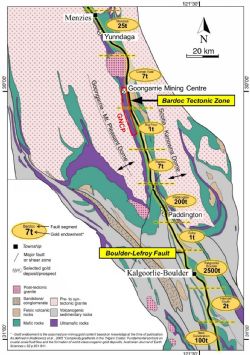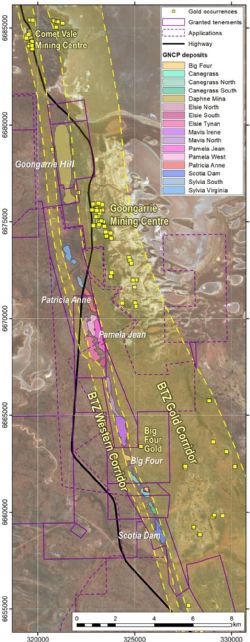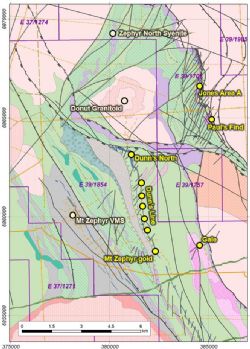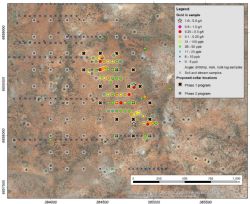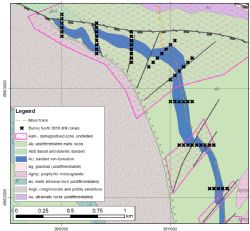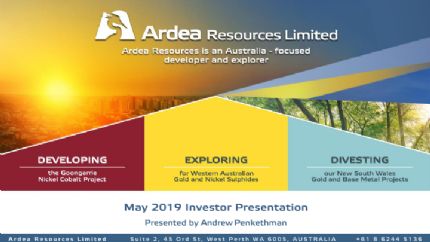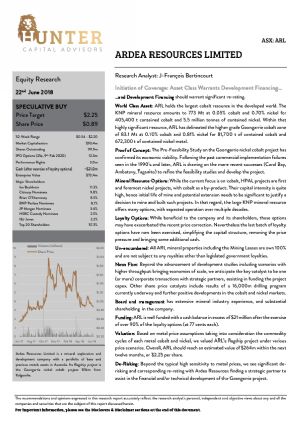Ardea's gold exploration programs for 2019 aim to realise potential of the Company's high-quality tenement package
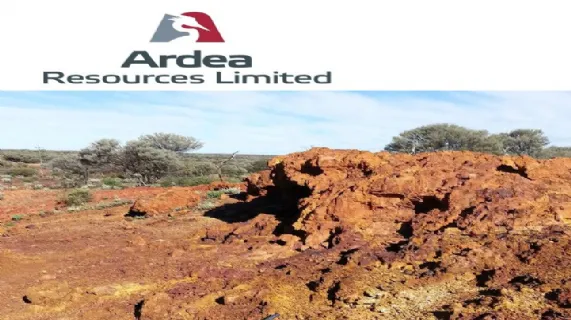
WA Gold Exploration Update
Perth, Nov 29, 2018 AEST (ABN Newswire) - With the recent completion of drilling at the Goongarrie Nickel Cobalt Project (GNCP), drill programs to test the highest priority gold and nickel sulphide targets in Ardea's ( ASX:ARL) (
ASX:ARL) ( ARRRF:OTCMKTS) extensive portfolio of Western Australian assets can commence shortly.
ARRRF:OTCMKTS) extensive portfolio of Western Australian assets can commence shortly.
Target generation programs covering Ardea's WA gold projects, particularly at Mount Zephyr and the Bardoc Tectonic Zone (within and adjacent to the GNCP) has highlighted numerous high-quality, gold prospects that require evaluation. These targets can now be advanced and if exploration is successful could add significant value to the Company's asset base.
- Newly acquired high-resolution geophysical datasets over the Goongarrie Nickel Cobalt Project define new gold targets across the highly prospective Bardoc Tectonic Zone
- A new geological interpretation for the entire Mount Zephyr greenstone belt significantly enhances the understanding of the region and provides a new targeting tool
o Numerous new targets defined and initial field assessments completed.
- Drill permitting advancing:
o At Mount Zephyr - drilling permits received for Jones Area A and Pauls Find. Applications submitted for Dunn's Line, Dunn's North and Gale following recent Aboriginal heritage surveys.
o At Goongarrie / Bardoc Tectonic Zone - permits in place in preparation for drilling.
- Initial gold and base metal drill programs aimed at the highest priority targets at Goongarrie and Mount Zephyr in WA.
The Bardoc Tectonic Zone (BTZ) at Goongarrie, WA
The BTZ is an 80 km long regional shear / fault system of the Eastern Goldfields province of Western Australia. It is a significant gold-producing structure that hosts the Paddington gold mine and the Goongarrie, Comet Vale, and Menzies gold mining centres. Around 20 km of the structure is located on Ardea's tenure at and around the GNCP. The fault system interconnects with the other major faults of the region, including the Boulder-Lefroy Fault to the south that hosts the Kalgoorlie mining centre (see Figure 1 in link below).
At Goongarrie, the BTZ underlies the entirety of the extensive lateritic nickel-cobalt deposits. It is host to the numerous historic gold mining operations that are exposed in bedrock at the Goongarrie gold mining centre and historic town site. That same sequence is almost completely buried beneath laterite cover adjacent to the nickel-cobalt orebodies of the GNCP. As such, surface geochemistry is not effective, so geophysical target definition and drill sampling is required.
Gold mines and occurrences within the BTZ are located within distinct corridors (see Figure 2 in link below). The main corridor lies east of the GNCP deposits and contains the Goongarrie mining centre and Ardea's Big Four gold mine. The thinner western corridor incorporates the Comet Vale mining centre as well as numerous gold occurrences detected during drilling of the GNCP.
Gold endowment varies significantly along the strike extent of the BTZ / Boulder-Lefroy fault system (see Figure 1 in link below). Centres such as Kalgoorlie, Paddington and New Celebration host significantly greater gold endowment than other segments of the fault system. Ardea considers that the low historic production on the Comet Vale and Big Four fault segments is in part a function of the lack of exposure in these areas. The Company therefore considers that there is potential for significant gold deposits beneath cover in the BTZ at the GNCP, considering the gold-bearing nature of the BTZ and Boulder-Lefroy Fault to the south. As such, this area is considered highly prospective.
New datasets acquired to assist in detailed target generation
Preliminary high resolution aeromagnetic, hyperspectral and digital elevation datasets have recently been acquired over the entire GNCP.
Final datasets are expected shortly. A substantial increase in resolution will significantly enhance Ardea's capability to define new gold targets throughout the area (see Figure 3 in link below).
Full processing and manipulation of the new data is presently underway with definition and appraisal of targets within and adjacent to the BTZ at Goongarrie to be carried out upon receipt of the final treated aeromagnetic datasets. A fully ranked target generation program will then be undertaken to ensure that full systematic testing of the highest quality targets is performed in 2019.
The historic Big Four Gold Mine is located on Ardea's GNCP tenure. First pass characterisation of its aeromagnetic signature shows that there are multiple similar style targets throughout the Company's ground for the entire strike length of the GNCP within what is termed the "Gold Corridor" (see Figure 2 in link below). All targets on Ardea's tenure are blind, being located beneath at least 20 m of lateritic and alluvial overburden, so will require drill testing.
Other styles of gold mineralisation are suggested by gold occurrences throughout the drilled areas of the GNCP. Significant gold anomalism within the laterite profile appears to be associated with various structure sets in saprock below the laterite, many well outside of the defined Gold Corridor. Such gold-in-laterite occurrences will be used to identify gold mineralisation targets in the bedrock below.
Geological appraisal of available outcrops and historic workings at Goongarrie and along strike is underway. The intent is to define in detail the geological controls on gold mineralisation in what is one of the less studied gold-hosting structures of the Eastern Goldfields.
About Ardea's Big Four gold deposit, BTZ
The Big Four gold project (see Figure 2 in link below)contains several old mine shafts which were worked in the early 1900s. Gold mineralisation is hosted by a brittle, fractured intermediate porphyry intrusive unit within the ultramafic Siberia Komatiite. The mineralisation is associated with quartz veining and pyrite/carbonate alteration. High-grade zones commonly contain coarse visible gold. The same porphyry rock type is commonly intersected in GNCP drilling, often with anomalous gold.
Most recently, mineralisation at the Big Four gold mine was drilled by Heron Resources in 2012. Heron defined significant gold hits (see Figure 4 in link below).
Ardea considers the gold mineralisation intercepted to date at Big Four to be indicative of only one of the styles of gold mineralisation expected to be encountered within the BTZ. It is proof-of-concept that will be used to justify extensive drill programs adjacent to the GNCP.
Significantly, the Big Four fault segment is a major resource outlier within the BTZ, with only 1 tonne of historic gold endowment compared to 7-200 tonnes in other mining centres between Paddington in the south to Menzies in the north (see Figure 1 in link below).
Forthcoming 2019 drill programs at Mount Zephyr, WA
The Mount Zephyr greenstone belt represents a prime exploration opportunity for Ardea. The belt has been largely overlooked over past decades, and only now (under Ardea's management) is a systematic regional targeting exercise to define the region's most prospective gold and nickel sulphide projects being undertaken.
The regional geology has never before been defined consistently in such detail across the entire greenstone belt. Only now are parallels in the geology being drawn, between areas such as the Mount Windarra area and Yamarna regions to the east, and the Kalgoorlie area to the south, highlighting target areas that have previously gone unrecognised. Multiple potential gold and base metal target areas are in the process of being defined, ranked and assessed.
Active Ardea programs are shown in Figure 5 (see link below) in bright yellow, with other gazetted, historically documented prospects and areas of interest shown in pale yellow. Newly generated targets presently under assessment are not shown.
First-pass drill programs at Jones Area A and Paul's Find are pegged out and ready to go. Recent access clearing and track rejuvenation was halted after the loader was bogged following very heavy rains across the Eastern Goldfields. The Company is also awaiting statutory DMIRS tenement approvals.
DMIRS Programs of Work (PoW) have been submitted for drill programs at Gale and Northern Dunn's. Both areas have undergone thorough Aboriginal heritage surveys recently. Whilst some heritage locations have been identified, both programs have been designed so that they can proceed without hindrance.
2019 RC drill program at Gale
A two-phase program of RC drilling is planned for the Gale gold prospect. The Company will commence drilling upon receipt of all necessary drill permits which are presently being assessed by DMIRS.
The first phase of drilling will comprise 21 RC drill holes spaced at approximately 160 x 160 m (thick black crosses, see Figure 6 in link below). Holes will mostly be to a 50 m depth, with several to penetrate to 100 m. The footprint of the program is approximately that of the surface outcrop gold anomaly. The program is expected to confirm historic results and provide a precursor to a second expanded phase of drilling.
Contingent upon the results of Phase 1, Phase 2 will extend the drill program to cover more of the interpreted extent of the mineralised granite under cover. This program will comprise an additional 42 RC drill holes beyond the defined surface footprint of the outcrop-limited gold anomaly. Full implementation of the program will cover an area measuring approximately 1,400 m x 1,050 m.
About the Gale prospect
The Gale gold prospect is defined by surface anomalism in gold, arsenic, copper and barium. The gold anomaly in surface sampling demarcates a footprint limited by outcrop extent of 900 x 300 m defined by 25 samples of various types each exceeding 0.1 g/t Au (see Figure 6 in link below). These values peak at 1.49 g/t gold. In the well explored Eastern Goldfields Province, such a surface anomaly is exceptional. Gold in soil values peak at a very high 273 ppb.
Mineralisation at Gale is hosted by granites and is associated with sericitic, pyritic, and hematitic alteration reminiscent of Dacian's Jupiter gold mine along strike to the south. Historic 1990s shallow RAB drilling returned anomalous geochemical results including:
- MZR004, 18 m at 0.51 g/t Au from surface
- MZR019, 18 m at 0.48 g/t Au from surface
- MZR020, 2 m at 3.12 g/t Au from 8 m
- MZR024, 2 m at 1.64 g/t Au from 2 m
- MZR049, 6 m at 1.26 g/t Au from surface
Attempts at the time to correlate intercepts vertically failed and the project was abandoned. However, Ardea's reappraisal of historic data using a sub-horizontal Jupiter-style model shows promise. More data is required, and this will be addressed with the forthcoming program.
2019 aircore program at Dunn's North
An initial aircore drill program at Dunn's North is designed to appraise deformed and altered banded iron-formation (BIF) units interpreted beneath cover adjacent to the newly defined E-W suture. The suture appears to be a south-dipping feature over which the BIF appears to have undergone significant deformation, re-orienting from a north-south strike to a roughly east-west strike.
Further south on Dunn's Line, historic gold workings are associated with faults in the banded iron-formation. In aeromagnetic data, such locations correspond to demagnetisation of the BIF units. Similar but more extensive and intense demagnetisation is recognised in aeromagnetic data at Dunn's North, which is overlain and completely obscured by alluvial and sheetwash sediments. The geochemical response of these transported sediments is not considered to be indicative of underlying potential. No historic drilling was found in Ardea field checking.
Dunn's North is a virgin target defined by Ardea, with no historic work of any kind apart from sparse, non-representative surface sampling. The target was identified and prioritised as a result of Ardea's regional appraisal and reinterpretation of the Mount Zephyr greenstone belt. As such, inexpensive aircore drilling is planned for first-pass testing of the target.
The Dunn's North area also comprises an extensive series of targets hosted by ultramafic rocks within the E-W suture. Intense demagnetisation is interpreted over an area measuring approximately 3.2 km by 1.4 km. If correct, such a demagnetisation zone would likely represent a very large hydrothermal event that, based on the Dunns Line to the immediate south, could possibly be gold-bearing. This area will be a target of forthcoming work.
Other Mount Zephyr drill programs
Programs are also ready to go at Jones Area A and Paul's Find on the eastern margin of the Mount Zephyr greenstone belt (see Figure 5 in link below).
- Jones Area A - outcropping base metal (nickel-copper sulphide) gossans adjacent to a banded iron-formation show similarities to the highly mineralised Mount Windarra stratigraphy on the opposite side of the Mount Margaret Anticline to the east. As on Dunn's Line, the BIF ridge is cross-cut by numerous faults showing local demagnetisation, suggesting hydrothermal alteration and the potential for gold.
- Paul's Find - recent gold prospecting activity in alluvials requires location of the bedrock gold source. Newly discovered, poorly exposed altered porphyries which deflect the greenstone-bounding fault system may be that source and require drill testing.
PoWs have been approved for these areas. They are likely to be drilled pending favourable final internal assessment.
In addition to these, numerous other targets are under assessment and will be ranked and, where appropriate, explored in due course.
A golden 2019
Ardea's gold exploration program will be systematic and extend to all project areas in 2019. Historic gold workings at Taurus (east of Kalgoorlie), Bedonia (east of Norseman) and Ghost Rocks (NW of Menzies on a probable extension of the BTZ) will be assessed and are all likely to be drilled. Secondary NSW gold projects will also be assessed, with Black Bullock, Ophir, Mount Aubrey, Yeoval and others being ranked and prioritised.
To view figures, please visit:
http://abnnewswire.net/lnk/LHE289X8
About Ardea Resources Ltd
 Ardea Resources Ltd (ASX:ARL) (OTCMKTS:ARRRF) (FRA:A91) is an ASX listed resources company, with 100% controlled Australian based projects, prioritising a three-pronged value creation strategy which is:
Ardea Resources Ltd (ASX:ARL) (OTCMKTS:ARRRF) (FRA:A91) is an ASX listed resources company, with 100% controlled Australian based projects, prioritising a three-pronged value creation strategy which is:
- development of the Goongarrie Nickel Cobalt Project, which is part of the Kalgoorlie Nickel Project, a globally significant series of nickel-cobalt deposits which host the largest nickel-cobalt resource in the developed world, coincidentally located as a cover sequence overlying fertile orogenic gold targets;
- advanced-stage exploration at WA gold and nickel sulphide targets within the Eastern Goldfields world-class nickel-gold province; and
- the demerger of the NSW gold and base metal assets with planned in-specie share distribution, with projects located within the Lachlan Fold Belt world-class gold-copper province.
| ||
|




